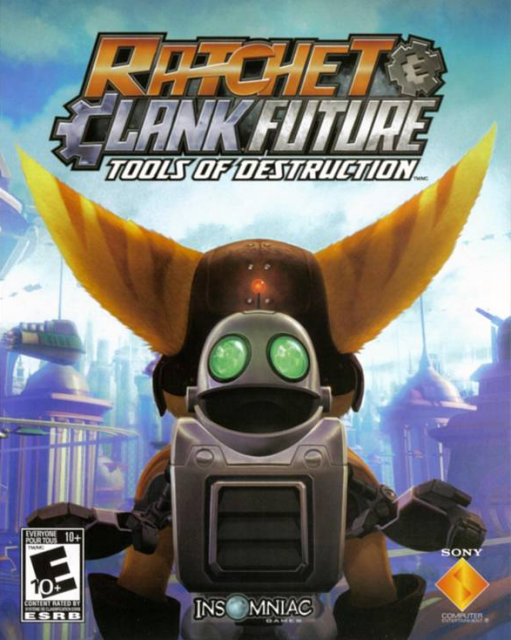You know how Ratchet and Clank games work by now – start off hitting enemies with a spanner, collecting bolts along the way, work your way up to a range of ridiculously awesome guns and other weapons, level up said weapons, throw in a bunch of boss battles, prettied-up quicktime events, and spend hours in front of a television screen at a time, grunting incoherently at flatmates as you shoot novelty ammunition at mutant goldfish. Well, that’s how it works for me.
Ratchet and Clank Future: Tools of Destruction is the first outing for Insomniac’s popular PS2 franchise on the PS3, and it’s fantastic. Utterly fantastic. Newcomers to the series can pick up a controller and get straight into the game without having to be told which buttons to press (although the tutorials are helpful), the graphics pop out of the screen in brilliant colours, and the in-game action is on par with cut-scenes from as little as two years ago. What’s more, the whole thing runs at a steady 60fps throughout the game.
Plot-wise, the basic gist of things is that you’re alternating between chasing the evil emperor Tachyon, running from him when he’s too powerful, and trying to get your hands on some kind of ultimate weapon before he does. Simple stuff, really. You do get to find out a little more about the history of the Lombaxes, which was teased pretty heavily in previous games; and, if you manage to get to the end of the game in one piece, you also get to prevent the destruction of the universe. Which is nice.
The basic storyline aside, the game actually has more in common with the likes of Mass Effect than previous Insomniac titles – although the developers have thankfully scrapped the central hub that was so infuriating in the most recent Ratchet game, Up Your Arsenal. Instead, you move from planet to planet, upgrading your weapons as you collect raretanium crystals (don’t even ask), and blowing up the aforementioned mutant goldfish. Fans of the arena battles still have the chance to battle it out against a range of enemies, although these can be skipped if you’re not fond of prizefighting.
Once you get into the grind of collecting bolts, firing increasingly extraordinary (but no less amusing) weapons at an array of enemies, you won’t notice the graphics. That’s not to say you won’t appreciate them, but after the first couple of hours playing, what you’ll be most impressed with is that the graphics don’t impede your progress in the game, are clear enough that you won’t get sore eyes after hours of playing, and are, simply put, as good as you have any right to expect from a next-gen game. This is living, you might say.
Aside from the tacked-on (and best forgotten) space shooter sequences between the real levels, a little quick-and-dirty level design near the end of the game is pretty much the only thing that mars my experience of the game. Separating platforms by massive artificial gravity jumps might sound cool, and may even look pretty to someone watching over your shoulder, but when the player has no input into the direction you’re travelling, all it becomes is a gussied-up version of Resident Evil’s opening doors loading screens. Granted, the creaking doors idea was a great workaround for a static loading screen, but in Ratchet, the level shouldn’t even need time to load, and adding in some element of difficulty to moving between platforms would have gone a long way towards improving player involvement in the level.
Overall, I’m damn impressed with the game. Now, I’m disinclined to think that a ten-hour game can redeem an (NZD)$800 machine, but I’ll be damned if Ratchet and Clank’s latest outing doesn’t smack the action-adventure ball right out of the park.
And here’s where Sony’s marketing machine kicks in. Ratchet is, along with Naughty Dog’s Uncharted: Drake’s Fortune, being held up as some kind a shining beacon of competitiveness, or some other abstract noun, against the more established Xbox 360. Prior to the summer release schedule, there were really only a few reasons why any sane gamer (with a limited wallet) would have chosen to buy a PS3, and those reasons were largely to do with the other things the machine can do – run Linux, join Stanford’s Folding@Home project to find novel cures for obscure diseases, accommodate a non-proprietary hard drive, and simply allow a greater deal of customisation. And now they’re adding some good games to the mix, exclusive games that weren’t originally designed for another platform? It’s about time.
Sony’s been on the back foot for a few reasons, and it’s not just because they launched their console almost a full year later than Microsoft. Sony also has a rather lacklustre online store, a good few rungs down the ladder from the 360, which was able to springboard off the success of the original Xbox’s Live service. Add to that an initially clunky XMB interface, a collection of mixed messages about peripherals such as the PVR add-on to the PS3 that’s supposed to turn up sometime “early” this year, launching without a rumble-pack controller, and the seemingly requisite bare-faced lies about why they didn’t provide the DualShock 3 from the beginning (it’s coming out “soon,” though), and it’s all a bit of a mess. Thank God for upgradeable firmware, you might say – it’s the only way Sony can dig themselves out of this little (piano) black hole. Well, upgradeable firmware and stellar titles like Ratchet and Clank Future. Things might be looking up.
